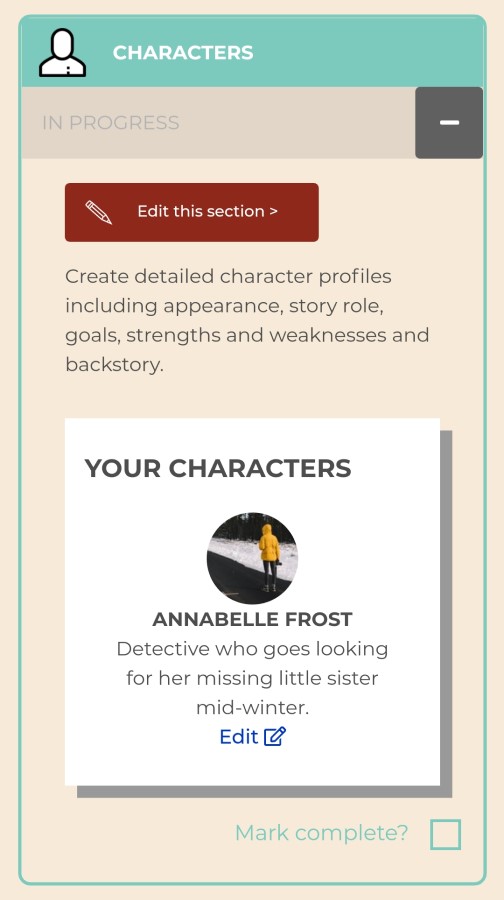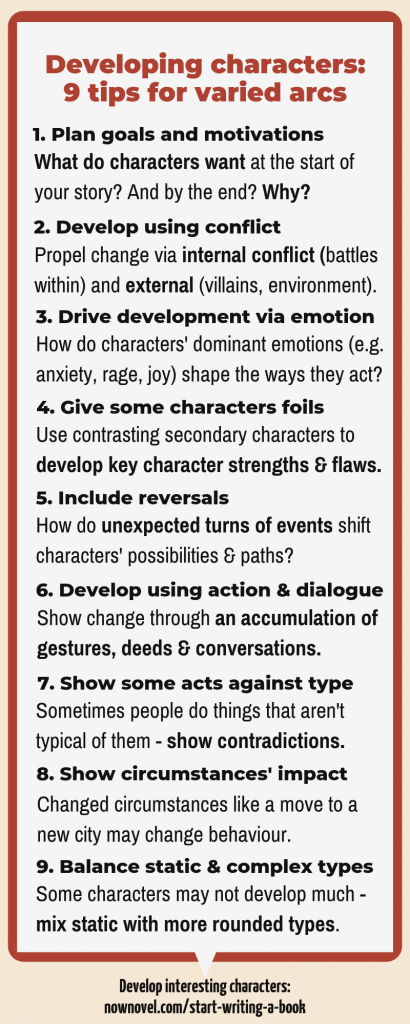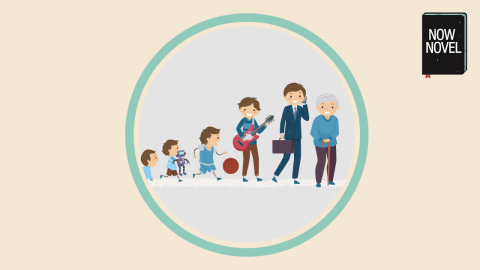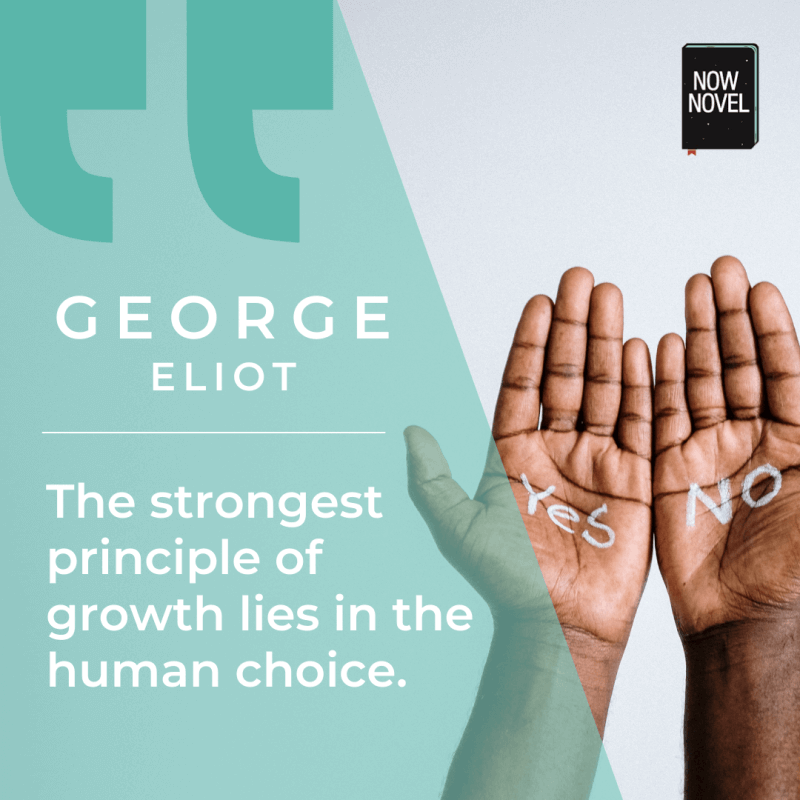Character development gives fictional characters depth. Like us, characters grow, change, make mistakes and learn (or don’t). Read 9 ways to make your characters grow and take readers on a great character arc:
How to take character development deeper:
- Plan characters’ goals and motivations
- Use conflicts to shape arcs
- Develop characters via emotional change
- Use occasional character foils
- Include turning points and reversals
- Develop characters using dialogue and action
- Let characters surprise you (and readers, too)
- Show the impact of changing circumstances
- Pair static arcs with fuller character development
Let’s explore these ideas about character growth in stories more:
1: Plan characters’ goals and motivations
Character development starts with motivations and goals.
What your characters wants to do, achieve (or avoid) shapes plot.
It’s like Ray Bradbury said:
‘Plot is no more than footprints left in the snow after your characters have run by on their way to incredible destinations.’
Ray Bradbury, ‘Zen in the art of writing: Essays on creativity’, p. 152.
Decide what your characters want, and why.
This is a crucial step in deciding what will happen next. You can use Now Novel’s ‘Characters’ dashboard to outline characters in easy steps:

Developing characters’ goals and motivations: Alec Leamas in The Spy who Came in from the Cold
At the start of John Le Carré’s 1963 Cold War spy novel, the British spy Alec Leamas is waiting tensely at an outpost for news from his best double agent:
The American handed Leamas another cup of coffee and said, “Why don’t you go back and sleep? We can ring you if he shows up.”
Leamas said nothing, just stared through the window of the checkpoint, along the empty street.
“You can’t wait forever, sir. Maybe he’ll come some other time. We can have the Polizei contact the Agency: you can be back here in twenty minutes.”
John Le Carré, The Spy who Came in from the Cold (1963), p. 3
“No,” said Leamas, “it’s nearly dark now.”
This simple opening exchange reveals Leamas’ goals and motivations:
- Goal: Making contact with his man in the field
- Motivation: Needs important information from the man. Further, Leamas is motivated to wait now by how late the man is (‘It’s nearly dark now’) – there is ominous portent that provides urgency
Already from the first scene, Leamas shows character development.
The face Leamas chooses to wait shows us something about his commitment to his agents, their safety, and his work.
The other man’s continued attempt to persuade him to turn in gives another important element of character development: opposition.
2: Use conflicts to shape arcs
Conflict is a conduit for character growth, and a major driving force in charater arcs.
In character development, conflicts can test your characters’ resolve (their commitment to their goals), or might add interesting battle scars (trauma) that shape future decisions.
A character who has been in an unhappy or abusive relationship, for example, may well avoid future intimacy due to the perceived risk.
We carry our pasts around, to greater and lesser degrees. We bring the templates or lessons they’ve given to new obstacles or conflicts, too (whether constructively or destructively).
So how can you create character development using conflict? The answer: Use internal and/or external conflict:
Internal conflict and character arcs
Internal conflict is the inner struggle a person experiences.
For example, a character who is often rebuked for being oversensitive may develop a complex about not showing their emotion too much.
Types of internal conflicts that can shape your characters’ choices and character development include:
- Unresolved fears: What does your character most want to avoid? Why?
- Competing choices or indecision: A character who loves freedom and wanderlust might be fearful of commitments such as fixed relationships or work contracts (they may be torn between love of freedom and the perks of security)
- Positive vs negative self-image: A character who has low self-confidence might doubt their intuition and ignore it, making choices that they may regret due to this
These are just some possible sources of internal conflict.
Brainstorming characters’ backstories will help you understand where characters’ internal conflicts come from.
To develop characters well, show how your characters grow and overcome internal conflict (or fall into the same habits and patterns – a more typical ‘tragic’ character arc).
External conflict and character development
External conflict is the conflict between a character and external elements such as:
- Antagonists: Characters whose goals are obstructive or opposing and thus create conflict
- Environment: For example, the battle between Santiago, an aging fisherman, and a marlin in Ernest Hemingway’s The Old Man and the Sea
- Society: For example, a character who is shunned by their society for non-accepted behaviour, such as Hester Prynne who has a child through an affair and is shunned by puritan society in Hawthorne’s The Scarlet Letter (1850)
- Supernatural forces: Many horror and supernatural stories involve conflicts between characters and malevolent, inexplicable forces, such as the struggle between the children and the shape=shifting evil that mimics children’s fears in Stephen King’s It
External conflicts may create character development by:
- Creating trauma: An emotional or physical wound adds to your character’s psychological makeup or burden.
- Creating obstacles that test a character’s progress: For example, in the Star Wars franchise, ‘the dark side’ is a destructive force that tempts a Jedi to betray a more righteous code. Brushes with the dark side thus develop a Jedi character
- They raise exciting uncertainties: External conflict often provides a real threat, whether to your main character’s survival or a goal they hold dear.
Use internal and external conflicts to create circumstances that test, change and grow your characters.
3: Use characters’ emotions to drive development
Just like real people, our characters have emotional inner worlds. Even if this world consists of a lack of emotion (or rather, of the ability to show emotion), this is still an emotional quality. We can compare it to how other characters feel, handle or display their own emotions.

Develop believable characters
Get our workbook How to Write Real Characters for practical exercises and examples.
GET GUIDEExamples of emotional states that drive character development
Think about a character you’ve developed or have thought about. What is their dominant emotion? It could be:
- Anxiety
- Optimism
- Melancholy
- Anger
- Joy
- Determination
These are just some examples of emotional states a character might slip into.
How does a determined/driven character act vs a mostly anxious one? What are the pluses and minuses of their emotional makeup when it comes to pursuing their goals? How might these emotions shape their motivations? (An anxious character, for example, will try to avoid situations that trigger their anxiety).
Know your characters emotionally and you’ll have the underlying currents and causes that shape their actions.
4: Give your main characters foils who contrast
Chris Baldick, in the Concise Oxford Dictionary of Literary Terms, defines a character foil thus:
‘A character whose qualities or actions serve to emphasize those of the protagonist (or of some other character) by providing a strong contrast with them. Thus in Charlotte Bronte’s Jane Eyre, the passive obedience of Jane’s school-friend Helen Bums makes her a foil to the rebellious heroine.’
Chris Baldick, ‘Foil’, The Concise Oxford Dictionary of Literary Terms (2001), p. 98
A foil might not be necessary. But a character like Jane Eyre’s school friend Helen is useful for developing a main character because:
- The contrasts between a character and their foil throw each characters strengths and weaknesses into relief, emphasizing their key attributes.
- Foil characters can supplement other characters’ strengths and weaknesses, providing contradiction, argument, or help when most needed. This element work in, for example, the figure of the ‘straight man’ in comedy – the straight-laced, level-headed character who brings a flighty, kooky character back down to earth.
Reversals – changes of fate or fortune – help to develop characters, too:
5: Include turning points and reversals
If you look at real people in your life, how many have developed in a simple, continuous line? In career, relationships and more, many people change, some more often than others.
Character reversals are larger changes of fortune that suddenly shift conditions, for better or worse.
Two examples of character reversals:
- Leaving an abusive home environment:
In J.K. Rowling’s successful Harry Potter series, there’s an early reversal in book one when the orphan title character, who lives with his unkind aunt and uncle, finds out he has been chosen to attend a magic school. This reversal takes Harry out of their malignant guardianship every school season, allowing him to grow and discover his worth and power. - Finding out the previously possible is impossible: In Kazuo Ishiguro’s Never Let Me Go (2005), characters raised in a home for children discover first that they are raised to donate organs (but there is a deferral system), then that deferrals aren’t allowed (in a horrifying twist)
The first reversal is a positive reversal – a character’s life develops for the better.
The second is a negative reversal, in that the sudden change in circumstances portends tragedy.
Sea changes such as these are useful for suddenly taking characters in new directions that give them space to confront new challenges, discoveries and struggles.
6: Develop characters using dialogue and action
How do we know a character has changed?
Often it’s because the character makes choices we wouldn’t have expected them to make. The coward defends the bullied kid. The bully shows vulnerability that reveals the underlying causes of his behaviour.
As Rick Meyer for Nieman Storyboard says,
‘Sometimes you’ll be tempted to develop characters by saying who they are. Show them instead.’
Beginning writers are often tempted to explicitly tell the reader how the main character has changed. Revealing actions are subtler and can add up over time to convey a sense of development.
Dialogue is also useful for this element of gradual change:
Example of using dialogue to develop characters
In the classic 1964 musical My Fair Lady, based on the play Pygmalion by George Bernard Shaw, Eliza Doolittle is a Cockney flower girl who takes lessons from a language professor so that she can speak like a lady, a more privileged member of society.
Throughout the play (and movie) the dialogue itself reveals Eliza’s development. She moves from speaking in Cockney dialect and slang to speaking in a ‘posh’ manner, to speaking in her Cockney accent again. The return to her own mode of speech reflects the important realization that her own worth and value is not dependent on class conformity.
To make your character development complex and believable, consider how changes in behaviour, speech and circumstances all intersect and can be used to paint a more convincing character portrait.

7: Let characters surprise you (and readers, too)
Although character development depends on showing a chain of cause and effect – how your character responds to specific situations – surprise is a useful element of character change.
A character acting out of type unexpectedly can drive home that they are reaching a new point in their narrative arc.
If a character who is normally greedy and miserly suddenly acts charitably and selflessly, this new development can spark a change of course in the story.
Surprises and twists throw the reader into a state of curiosity and suspense. They make us want explanations, so they’re useful for adding contrast and intrigue. However, moderation (as in many things), is key.
Having your characters change mood, motivation or habit every other chapter could make them seem too inconsistent. If you do this, make sure there is an explanation that upholds your story’s internal logic.
8: Show the impact of changing circumstances
Your character’s circumstances might change in many ways in the course of your story. They might travel to a new location, they might form or lose relationships with others. Perhaps they form new beliefs and opinions or re-evaluate old ones.
Make your character development ring true by making each of these elements of change shift your character’s inner world, too.
A change in city might change your character’s way of life and emotional life-world just as much as a change of romantic partner could. If you change a character’s circumstances, brainstorm the possible ways it can affect their motivations, goals, hopes and dreams moving forwards in your story.
9: Pair static arcs with fuller character development
Sometimes your primary character might step into your story more or less fully formed. This is typical of action thrillers, for example, where the hardened tough guy must simply navigate and solve a new set of dangers.
When you have a flat character arc (or static character), create interest by giving your secondary characters their development of their own.
Round characters who have depth and complexity can add surrounding dimension to an otherwise ‘typical tough guy’ protagonist, for example.
Contrast between characters is key to creating an ensemble of well-developed characters who feel real.
Brainstorm character profiles in easy steps on Now Novel and develop characters further with hands-on help from our writing community or a coach.





3 replies on “Character development: 9 tips for arcs with depth”
[…] Character development: 9 tips for convincing arcs via Now Novel […]
[…] – Character Development: 9 Tips for Arcs with Depth […]
[…] Character Arcs With Depth […]